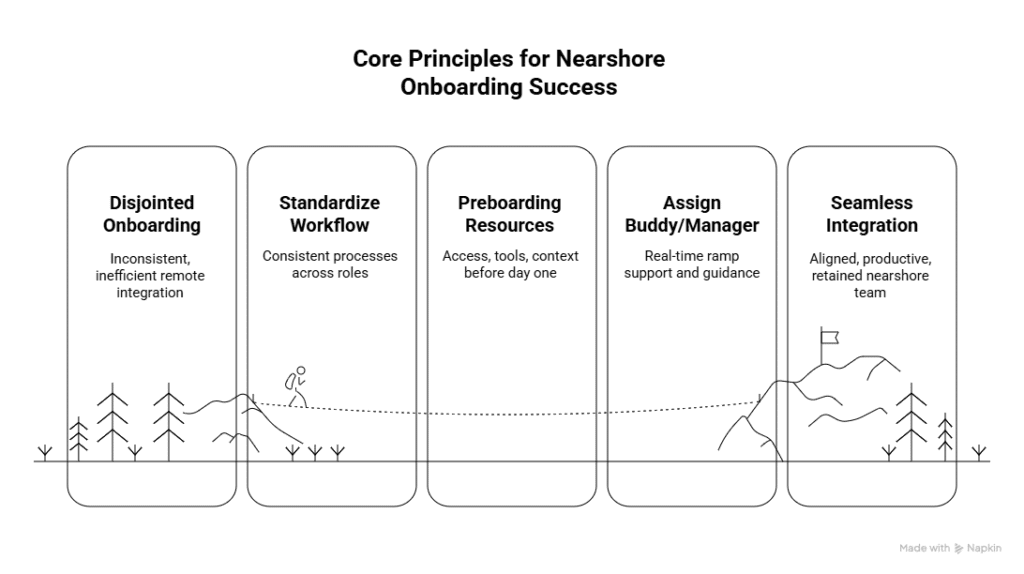Remote onboarding helps ensure your new hires feel connected, informed, and prepared from day one is essential for productivity and retention. Without proper planning, remote onboarding can lead to confusion, disengagement, and missed opportunities to integrate employees into your company culture.
You need clear strategies that streamline communication, provide structured training, and foster collaboration in virtual environments. From leveraging digital tools to creating personalized onboarding plans, adopting best practices ensures every team member starts strong—no matter where they’re located.
Are you ready to optimize your remote onboarding process and set your new hires up for success? Let’s explore actionable steps that make a lasting impact.
Core Principles for Nearshore Onboarding Success
Effective onboarding of nearshore employees ensures alignment, productivity, and retention. By focusing on structured workflows and communication strategies, you can integrate remote professionals seamlessly into your team.

#1 Standardize the Onboarding Workflow Across Roles and Regions
Establish consistent processes to onboard nearshore hires efficiently. Create a unified workflow that applies across roles like engineering teams or marketing roles titles while accommodating regional nuances in Latin America. Use templates for job-specific training plans, compliance checklists, and performance benchmarks to reduce variability. This approach simplifies scaling nearshore staffing operations and maintains quality regardless of location.
Standardization minimizes confusion during onboarding by providing clear expectations for both US-based managers and LATAM hires. For example, define steps such as tool access setup, company policy briefings, and role-specific training modules upfront to ensure every hire receives the same level of preparation.
#2 Start Preboarding With Access, Tools, and Context Before Day One
Prepare nearshore employees with essential resources before their first day. Share login credentials for collaboration tools like Slack or project management platforms early. Provide an overview of your company’s mission, values, and key projects so they understand their role’s context within broader business goals.
Preboarding reduces downtime during initial weeks by equipping new hires with the tools needed to contribute immediately. For instance, sending equipment (laptops, software licenses, or credentials) ahead of time ensures readiness from day one. This is especially critical when hiring full-time employees outside the US who may face logistical delays without proactive planning.
#3 Assign an Onshore Buddy or Manager for Real-Time Ramp Support
Pair each nearshore professional with an experienced onshore colleague or manager who can offer guidance during their ramp-up period. A buddy system fosters connection between remote LATAM hires and US-based teams while addressing questions about workflows or cultural differences in real time.
This strategy enhances engagement by creating a support network tailored to individual needs. For example, assigning a mentor familiar with cross-border recruiting challenges helps bridge gaps in understanding local practices versus global standards.
#4 Use Time Zone Overlap Windows for Synchronous Onboarding Sessions
Leverage overlapping work hours between US timezone teams and LATAM talent for live training sessions or Q&A meetings. Prioritize synchronous activities like virtual introductions or collaborative workshops during these windows to build rapport among distributed team members.
Time zone alignment improves communication efficiency by enabling immediate feedback loops rather than delayed responses via asynchronous channels alone. For example, scheduling daily stand-ups at mutually convenient times keeps everyone aligned on priorities even though geographic separation.
#5 Set 30/60/90-Day Goals With Clear Deliverables
Define measurable objectives tied directly to role responsibilities within the first three months of employment. Break down expectations into 30-day increments covering knowledge acquisition (e.g., mastering internal systems), skill application (e.g., completing assigned tasks), and independent contribution milestones (e.g., leading small projects).
Goal-setting provides structure that accelerates integration into your organization’s workflows while clarifying success metrics upfront—critical when managing teams across US-LATAM borders where misaligned expectations could lead to frustration or turnover risks.
#6 Provide Function-Specific Documentation and SOPs
Offer detailed documentation tailored specifically toward each department’s operational needs—for instance: coding guidelines for engineering teams; campaign briefs/templates for marketing roles; sales scripts/playbooks optimized for remote sales team contexts—to streamline learning curves significantly faster than generic materials would allow otherwise!
Comprehensive standard operating procedures empower long-term nearshore hires through clarity around best practices unique not only functionally but regionally too!
Role-Specific Onboarding Considerations
Tailoring onboarding to specific roles ensures new hires quickly adapt and contribute. Each department requires unique tools, training, and processes for optimal performance.
Sales: Product Training, CRM Access, and Shadowing Playbooks
Equip your remote sales team with product knowledge through structured virtual training sessions. Provide immediate access to the customer relationship management (CRM) system so they can familiarize themselves with leads and accounts.
Share shadowing playbooks that outline successful sales calls or demos from experienced team members. For remote sales teams in LATAM, ensure materials are available in C1/C2 English to avoid miscommunication. Use time zone alignment to schedule live role-playing exercises for real-time feedback.
Marketing: Campaign Systems, Brand Guidelines, and Asset Repos
Introduce marketing hires to campaign management systems like email platforms or social media schedulers on day one. Share detailed brand guidelines covering tone, visuals, and messaging consistency across channels. Grant access to centralized asset repositories containing templates, past campaigns, and creative resources.
If hiring nearshore marketing professionals from Latin America, clarify expectations around US market conditions while leveraging their regional expertise for bilingual content creation.
Engineering: Dev Environment Setup, Codebase Access, and CI/CD Practices
Provide engineers with clear instructions for setting up development environments remotely. Grant secure codebase access using version control systems while outlining repository structures. Explain continuous integration/continuous deployment (CI/CD) practices through documentation or recorded walkthroughs to streamline workflows.
When working with engineering teams in similar time zones as the US, use overlapping hours for pair programming or sprint planning sessions to enhance collaboration efficiency.

Tools and Systems that Enable Onboarding at Scale
Efficient onboarding systems are essential for integrating nearshore employees into US-based teams. Leveraging the right tools ensures seamless communication, task management, and knowledge transfer across distributed teams.
Knowledge Bases, Wikis, and LMS Platforms
Centralized platforms like knowledge bases or learning management systems (LMS) provide consistent access to company resources.
These tools store standard operating procedures, training materials, and FAQs in one location. For nearshore recruitment scenarios, they help C1/C2 English LATAM talent quickly understand workflows without constant guidance from onshore managers.
Wikis enable collaborative updates to documentation, ensuring relevance as processes evolve. Using an LMS allows you to track progress for long-term remote staffing goals while maintaining alignment with compliance standards.
Async Video Walkthroughs and Recorded Trainings
Recorded trainings offer flexibility for remote hires in Latin America working across time zones. Pre-recorded video walkthroughs of CRM setups or marketing campaign tools reduce repetitive explanations for roles like sales job titles or engineering teams.
They also ensure consistency in delivering critical information about US-specific market practices or technical guidelines. Sharing these recordings through secure channels fosters independent learning among full-time nearshore employees while keeping them aligned with organizational objectives.
Structured Onboarding Dashboards and Task Tracking
Onboarding dashboards simplify tracking tasks for both new hires and HR teams managing cross-border recruiting efforts. Integrating project management software enables clear visibility into 30/60/90-day deliverables tailored to each role—whether it’s marketing roles or engineering-focused positions requiring CI/CD setup completion.
Dashboards centralize timelines, feedback loops, and performance metrics to support retention planning for remote hires while streamlining operations during rapid headcount expansion within a nearshore hiring model.
Legal and Compliance Touchpoints for LATAM Hires
Ensuring compliance when onboarding remote employees in Latin America is critical to avoiding legal risks. Addressing key areas like document workflows, training requirements, and security protocols helps create a seamless process for nearshore recruitment.
Document Collection and Digital Signature Workflows
Streamline document collection by using secure digital platforms that support e-signatures. For compliant hiring in Latin America, gather essential documents such as identification, proof of address, tax registration forms, and work permits where applicable. Ensure these align with local labor laws in countries like Mexico or Colombia.
Carry out automated workflows to track missing paperwork and deadlines. This reduces administrative delays during the nearshore hiring process while ensuring all contracts meet regional standards. Platforms offering audit trails provide added transparency for long-term recordkeeping.
Using compliant tools simplifies onboarding full-time nearshore employees without requiring physical office visits.
Regional Compliance Training and EOR Coordination
Provide mandatory compliance training tailored to LATAM regulations. Cover topics like workplace safety laws, anti-discrimination policies, and data protection standards specific to the hire’s country of residence. For example, Brazilian hires must understand LGPD (Lei Geral de Proteção de Dados) requirements.
Partner with an Employer of Record (EOR) service if you lack a local entity. An EOR manages payroll processing, benefits administration, and tax filings on your behalf while adhering to regional employment laws. Collaborating with an experienced EOR ensures smooth operations when scaling teams with nearshore professionals across multiple jurisdictions.
IP, NDA, and Role-Specific Security Briefings
Protect intellectual property by having new hires sign NDAs before granting access to sensitive information. Draft agreements that comply with both US law and the employee’s local jurisdiction to avoid enforceability issues later.
Conduct role-specific security briefings for engineering teams nearshore or marketing roles nearshore based on their responsibilities. For instance, train software developers on secure code practices or educate marketers about safeguarding customer data under GDPR-equivalent rules in LATAM countries.
Reinforce ongoing accountability through periodic refreshers tied directly to performance management for nearshore teams working remotely from Latin America.
Scalable Onboarding Starts With Repeatable Systems
Creating a seamless remote onboarding experience requires intentionality and the right systems. By focusing on structured processes, leveraging digital tools, and tailoring strategies to meet regional needs, you can set your new hires up for success from day one.
Consistency is key when scaling your onboarding efforts across teams and locations. Standardized workflows, clear communication channels, and centralized resources ensure every employee receives the support they need while maintaining operational efficiency.
When you invest in repeatable systems that balance personalization with scalability, you’re not just onboarding employees—you’re building a foundation for long-term engagement and productivity.
Onboard Remote Talent That Performs From Day One
Book a Strategic CallFrequently Asked Questions
What is remote onboarding, and why is it important?
Remote onboarding is the process of integrating new hires into a company when working remotely. It ensures employees feel connected, prepared, and productive from day one, which boosts retention and engagement while minimizing confusion.
How can businesses improve their remote onboarding process?
Businesses can enhance remote onboarding by using structured workflows, clear communication strategies, digital tools like LMS platforms, and personalized plans. Preboarding activities and assigning an onshore buddy also help streamline the experience.
Why is preboarding essential for remote employees?
Preboarding provides new hires with access to tools, resources, and company context before their first day. This reduces downtime and helps them hit the ground running.
What are some best practices for nearshore employee onboarding?
Best practices include standardizing processes across regions, leveraging time zone overlaps for synchronous sessions, setting measurable goals (30/60/90-day plans), and providing role-specific documentation.
How should companies onboard sales teams remotely?
For sales teams, focus on virtual training programs, immediate CRM access, shadowing playbooks, and clear communication tailored to regional needs like LATAM markets.
What does effective marketing team onboarding involve?
Introduce campaign management systems, brand guidelines, centralized asset repositories, and clarify expectations regarding market nuances such as US consumer behavior.
What are key considerations for engineering team onboarding?
Provide clear instructions for development environment setup, secure codebase access protocols, CI/CD practices training, and schedule overlapping hours for collaborative tasks.
Which tools support scalable remote onboarding?
Centralized platforms like knowledge bases or LMS systems aid in consistent resource sharing. Task tracking dashboards simplify task management for HR teams and new hires alike.
How do asynchronous video trainings benefit remote onboarding?
Asynchronous videos provide flexibility by allowing employees to learn at their own pace while ensuring consistency in delivering critical information across teams.
What legal considerations apply to nearshore employee onboarding in Latin America?
Ensure compliance with local labor laws through secure document workflows (e-signatures), region-specific compliance training programs, NDAs for IP protection, and partnering with an Employer of Record (EOR) for payroll management.





